Gujarat is a very interesting state to discover the Jain religion (5 million followers worldwide), but also the Muslim religion, very present with mosques everywhere. Located in the west of India, Gujarat offers varied landscapes, excellent roads, and… very few trains. I don’t know why, there is a railway network, but very few trains run there. So travel is by bus with, for me, added fatigue. English is very little spoken in this state; however, I always found someone who spoke it. And fortunately, because all the information is in Gujarati (the local language)…

316 km from Mandu, it took me 12 hours to reach my destination, with 3 buses and 1 train! My fear was confirmed: I beat my record for slowness in transport in India, despite reduced waits at each change. Left at 8:15 in the morning, I put my bag down at 8:15 p.m. Long day of transport and especially tiring with the buses. And again, I ended up by train instead of taking one or two additional buses.
First thing to do: find a place to stay for 4 nights. As always at this time, it is much less obvious than before 6 p.m. After being refused several times in hotels even by moving up a category, I managed to find one for only… one night at a reasonable cost considering the range (1100 rupees all the same). In fact, all the accommodations are stormed because of the vadfest (Vadodara festival) for a week and it so happens that I arrive right in the middle of it…
In order not to waste time, instead of going to bed, here I am in the street at night looking for accommodation for the following days, without success. One thing is sure, no question of spending hundreds of rupees to sleep. At worst, I leave the city.
The next morning, being next to the new bus center, I took the opportunity to find out about my next destination. The new bus center is in fact a brand new mall on 5 floors with more than 300 spaces for small shops (3/4 are still empty). A real Western-style shopping center. It is also, I am told, the largest bus center in India with 16 platforms for buses (the catch: everything is in Gujarati for the timetable)!!! And the most surprising, 2 large dormitories on the second floor: 1 for men, opened 1 month ago and 1 for women under construction.
Still little known, it is almost empty, so this is where I stayed for the next 3 nights. Phew, here I am settled. Another surprising thing, on the third floor a large closed hall with an Italian-style decor for eating. Here several counters offer varied cuisine as part of a cooking competition. Then the meal is taken in the hall with from time to time a projection on a white wall in the style of the Festival of Lights of Lyon. All this, only during the festival. Needless to say, I took the opportunity to eat something other than Indian dishes. And for those who are bored, right next door, there is a video game room…
During the davfest, the cathedral was closed and all the masses were in the sanctuary. Blessed davfest, thanks to this I discovered a sanctuary dedicated to Mother of the abandoned (the Virgin Mary), hidden in small streets. Mass in the morning and… in the evening, with crowds and a special animation during the festival. What happiness. On the eve of the march for life in Paris in January, I took the opportunity to entrust to Mary, our sick France and also the whole world, which kills its (future) citizens.
Mother of the Abandoned, welcome under your protection all those whose lives are threatened by men and bless those who give death as well as those who give the order so that they can discover how precious life is and that it is a gift from God. Amen.
Vadodara is a city that does not exist in tourist guides, because there is nothing interesting to visit that would be worth stopping there. Well yes, maybe to discover the new mall 2 steps from the train station and the small sanctuary of Mother of the Abandoned 3 km away (Mother of the Foresaken in English). In fact, I stopped there to have Sunday mass and because it is a gateway to visit Gujarat. The second reason was to visit Pavagadh nearby.
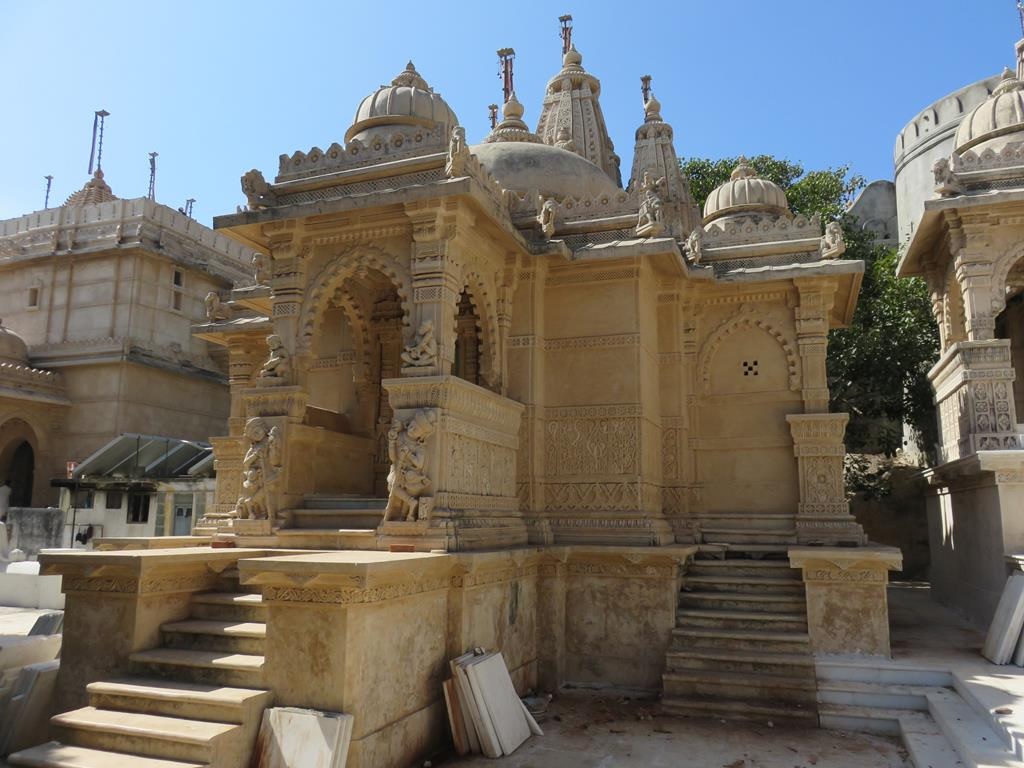
Located about sixty kilometers east of Vadodara, Pavagadh is a hill station with a Hindu temple at the top (Kalika Mata temple), perched at an altitude of nearly 800 meters. The site is located in a 10th century archaeological park. To get there, the journey can be done entirely on foot, or by jeep followed by the cable car. To avoid taking too long to climb (and avoid driving), I took the jeep to do the first 5 kilometers and then I finished the journey by climbing more than 1500 steps in a little over an hour.
Here it is impossible to die of hunger or thirst, there are shops all along the steps. The advantage: there are tarpaulins that provide shade (to protect the goods), the disadvantage: you don’t enjoy the landscape much. Once at the top, there are also shops right up to the foot of the temple.
But then how do we transport the astronomical quantities of goods knowing that there is no road or heliport? On the backs of men? Well no, on the backs of donkeys. Here, dozens of donkeys regularly go up and down (as well as their shepherds) the 1500 steps (some of which are quite steep) to satisfy our desires for consumption…
The reward, once you reach the top, is to enjoy the landscape and the Hindu pilgrims happy to go and worship at the temple (some come from far away). In itself, the temple is small and is not architecturally interesting. On the other hand, the fact that few tourists come has given me some great encounters. That is the advantage of going to places that are not very touristy.
Jainism
Before reading the rest, I strongly advise you to read Jacques-Henri Prévost’s article on Jainism. The article is a bit long, but it is the one that explains Jainism quite clearly. This religion-philosophy is quite complex to understand, but it deserves a closer look because it has influenced certain people including Mahatma Gandhi.
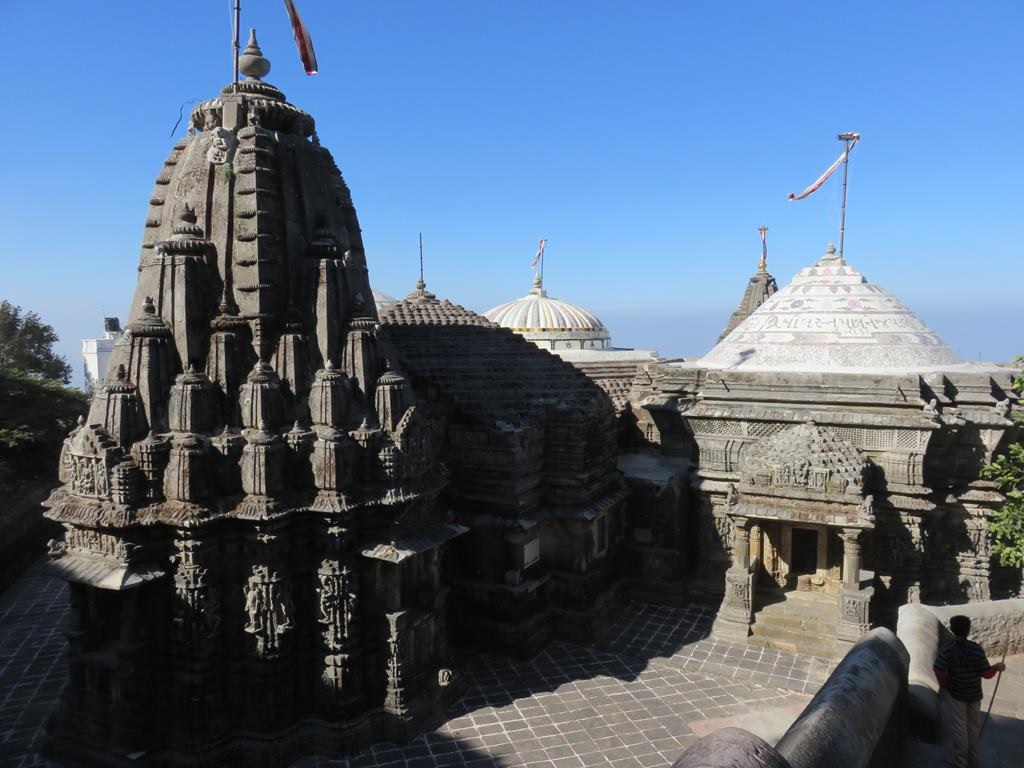
Shatrunjaya Hill (meaning victory square, at an altitude of 600 meters) is one of the 10 sacred places for the Jain community, located 320 kilometers west of Vadodara and 2-3 kilometers from the center of Palitana, which serves as a drop-off point for all amenities (there are not really any interesting things to visit).
It is at this place that Adinatha or Rishabha (9th century BC), attained enlightenment (liberation). For some, he is considered the first Jain tirthankar (person who overcame the cycles of death and rebirth) and therefore the founder of Jainism, for others it would be Mahavira (6th century BC), the 24th tirthankar, the reformer of Jainism.
Access is only on foot: 3600 steps to climb in nature to reach a collection of 850 Jain temples and 3500 gods. Personally, it took me 1 hour, stopping only a few seconds here and there, the goal was to arrive before the sun hit hard (there are few shaded places). The temples were built between the 11th and 12th centuries and then between the 14th and 16th centuries.
The temples are grouped into 3 groups, each surrounded by a wall, including 1 large temple and then all around dozens of small temples (most are tiny) all very well maintained. The Jains constantly polish the place and especially all the gods (some of whom are even dressed). An atmosphere of prayer and peace reigns here, and you are welcomed for what you are. Jains do not force you to make this or that offering, they essentially count on the generosity of your heart.
And what strikes me the most: seeing people smiling and happy to come to pray here (or to live here). I really perceive a beautiful little tight-knit community. If you have any questions, please ask them, the Jains will be delighted to chat with you.
Note: while visiting the main temple (in the group on the left), I saw people going upstairs. Curious as I am, I also went up (everyone can go there). Then I saw some of them go through a small door giving access to the upper floor (access reserved). I did the same and found myself above the heart of the temple. Then, I went through a tiny door leading to the rather steep roofs (access prohibited).
And at the highest point of the roofs, I saw men singing and shouting with joy… Suddenly, festive atmosphere and breathtaking view of the landscape. Of course, I asked permission to do so knowing that it is very exceptional (moreover I do not know why it was done).
On the way back, I met an Indian who currently lives in America and who comes on pilgrimage here every year. So I took the opportunity to ask him questions about Jainism, very good meeting. This place is an essential stop in Gujarat.

Porbandar is located 120 km south of Junagadh, on the shores of the Arabian Sea. Here I am in the south of Gujarat in the birthplace of Mahatma Gandhi (1869-1948), the one who defended his country against the English to one day obtain the independence of India (in 1947), by preaching peace and non-violence. He is the hero of Indian history, he is present everywhere: on all bank notes, each city has an important street named after him (M.G. road), statues everywhere…
So I visited his birthplace, then right next door the museum dedicated to him, in order to understand his life a little better. Apart from that, Porbandar is just a coastal town with its port (and its boat building) and its beach that offers nothing else interesting to visit. Only stop there if you have time to waste.
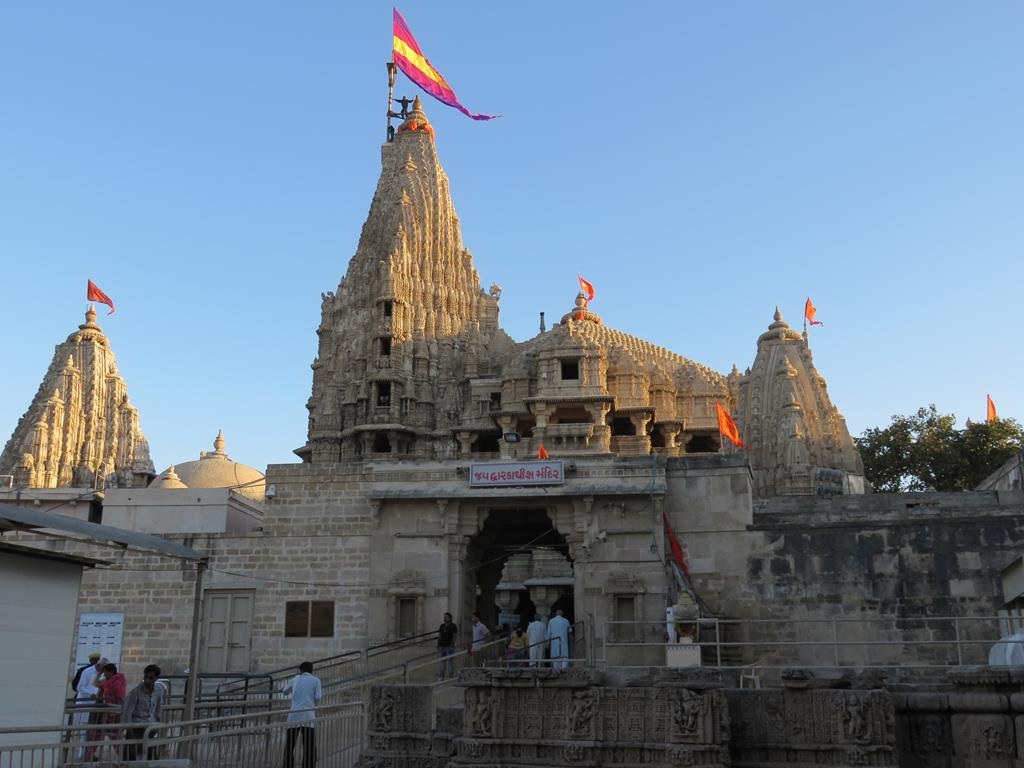
111 km west of Porbandar, Dwarka is one of the 4 places where a Hindu can make his most sacred pilgrimage (with Kedarnath to the north, Puri to the east, Rameswaran to the south and Dwarka to the west). It is a coastal city, with an impressive number of accommodations of all categories to accommodate pilgrims.
All the shops are mainly located around the Dwarkadhish temple dedicated to Krishna, located near the sea. The stone temple is small, it has the particularity of having 5 floors. In short, the visit to the temple is very quick, but the fervor of the Hindus is very present. Apart from the temple, there is nothing else to visit. To complete the visit of the region, do not hesitate to go to the island of Bet Dwarka.

Bet (Beyt) Dwarka is an island off the coast of Okha, located at the tip of Gujarat west of Dwarka (30 km). The tourist guide I have mentions that there is a temple with a giant statue of Krishna, which is what motivated me to go there. Well, none of that, it doesn’t exist on the island… In fact, there is the Shri Dwarkadish temple where many people come to pray as part of their pilgrimage after Dwarka.
The temple is also small and the visit is necessarily guided. So I joined the group. The guide was quite dynamic (everything is in Gujarati) and we followed a small circuit passing in front of deities. Some deities are hidden behind doors, the group waits, the excitement rises and suddenly… the doors open and the group lets out a cry of joy. And there you go, we move on to the next deity!!! And quickly, because there is another group waiting. When the group had stopped for a teaching time (?), I slipped away…
The visit was quickly over, so I took off (from the crowd) and headed towards the tip of the island 6 km away, crossing the small streets of the village, then I took a shared rickshaw that dropped me off at the temple at the end of the island, and finally I finished the journey on the seaside for 2.5 km… in the company of a group of young people and teachers.
When explaining to some Indians that I wanted to go to Dunny Point (the tip of the island), a class teacher offered to take me with his young people. When I arrived at Dunny Point, I discovered a camp where they had set up for 3 days. This camp is open from November to March only for school trips. It is an area prohibited to visitors because of the conflicts with Pakistan, the border being close. But hey, being invited, I was able to stay there, swim with the young people and have lunch with them… Very good time together, they were delighted to see me (they must not see foreigners very often) and me too, and funny thing on the day of Saint John Bosco.
On the way back, I stopped at Mithapur where I was able to have the anticipated Sunday mass. Oh yes, there are very very few Catholics in Gujarat (a few hundred), so the churches are naturally few and the masses too. Finally, by anticipating things a little I get there.
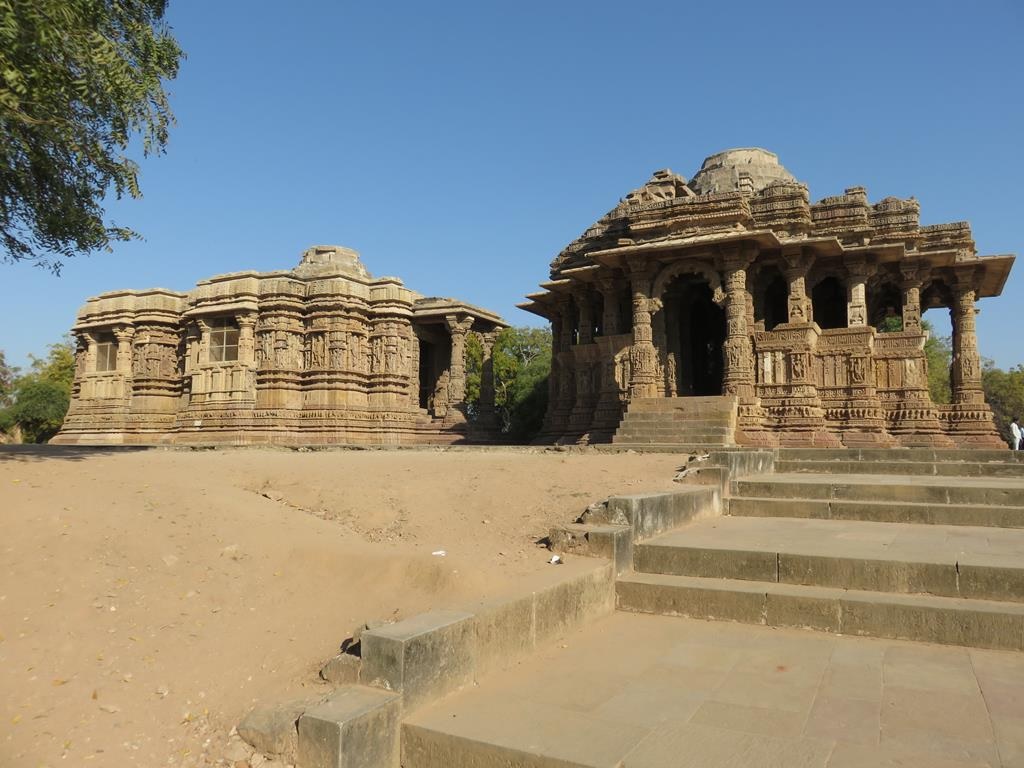
150 km north of Dwarka, it is a stopover town to go to the northwest of Gujarat. This town suffered major damage in a major earthquake in 2001. It is built around an artificial lake (currently empty) with a palace in its center, which has become a museum that I have not visited. This is also where you will find the only solarium in the world that allows you to treat skin problems directly with the sun’s rays using a system of mirrors.
The second one, which was built in France, was destroyed during the Second World War. It had been recommended to me by the class teacher I met in Bet Dwarka. Except that it was damaged in 2001 and there are no more spare parts to repair it. It is currently closed (hidden under tarpaulins) due to the construction of a new, more modern solarium. Finally, in the old town, there are scattered all over the place magnificent Jain temples richly decorated inside that are worth stopping by.
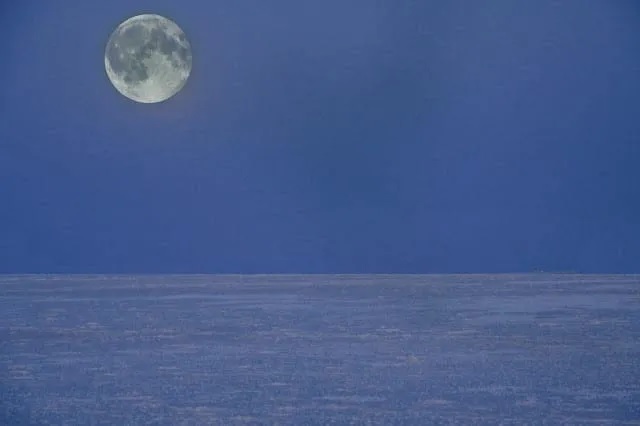
The Kutch (or Kahchch) district is located in the northwest of the state of Gujarat, bordered by the Arabian Sea to the south and west and by Pakistan to the north. The district is divided into 3: the Rann of Kutch located in the north which includes the White Rann, the Little Rann to the east which includes a reserve that shelters the last Asian wild asses, and the Great Rann for the rest of the region. Kutch is part of the Thar Desert (with also a part in the state of Rajasthan and a part in the south and east of Pakistan).
Rann in Hindi literally means “something that intermittently becomes wet and dry”. Kutch means “desert”.
This district suffered a major earthquake in 2001 (7.9 on the Richter scale), leaving a lot of damage. Today, life has resumed its course, still leaving some visible traces.

Here I am in the capital of the Kutch district (located in the Great Rann), 300 km from Jamnagar. Bhuj is the city from where we leave to explore the surroundings, which is one of the most visited places in Gujarat by all tourists, locals and the Indian government!
The city deserves a day’s stop to visit some rather interesting monuments:
The Pragmahal Palace: built in an Italian Gothic style in the 19th century, it was seriously damaged by the 2001 earthquake. While the exterior walls are relatively in good condition (with some nice cracks), the interior has not really been restored: we walk on concrete, the furniture is completely damaged, the ceilings are falling apart and pigeons come to live in the place with all the dirt that brings.
However, there is just one large room that has been restored (the first one we visit) that is worth a look and the 20 rupees entrance fee. To take pictures of the room, it is 50 rupees more (the rest is free). To complete the visit, we will have a view of the city from the top of the clock tower.
The Aina Mahal: located right next to the Pragmahal palace, it was built in the 18th century and partially destroyed by the earthquake. It is made of white marble, decorated with gold, mirrors installed everywhere and magnificent furniture, paintings, pictures… all this in a Hindu European style. I did not take any pictures, because I did not pay the extra entrance fee (50 rupees) especially since there is little light to take beautiful pictures. A must visit.
The Swaminarayan Smruti Mandir Temple: a new Hindu temple made entirely of white marble, it was officially inaugurated in 2010. It replaces the old temple destroyed in the earthquake. It is located in the center of a large hotel complex. The whole thing is quite impressive. To the left of the temple, there is a: modern museum, presenting various old objects, I think related to the old temple. The museum is not really signposted and the free entrance is a bit hidden (curiosity is an asset). A must-see. Photos are prohibited.
Visiting the villages in the region to discover local crafts: it is possible to do this, the easiest is to go to the tourist office for information. Kodak 10 km north of Mandvi, I stopped at Koday to visit a Jain temple that is currently being finished. It is located on the side of the road. As in Bhuj, it is a large complex with a temple made of white marble, finely carved by hand and with a grinder. It is quite impressive to see what men are capable of doing: beautiful. It is surrounded by an enclosure comprising a few dozen small temples, each containing a statue. The temple is open to all, it is active. However, photos are also strictly forbidden there. Worth a visit.
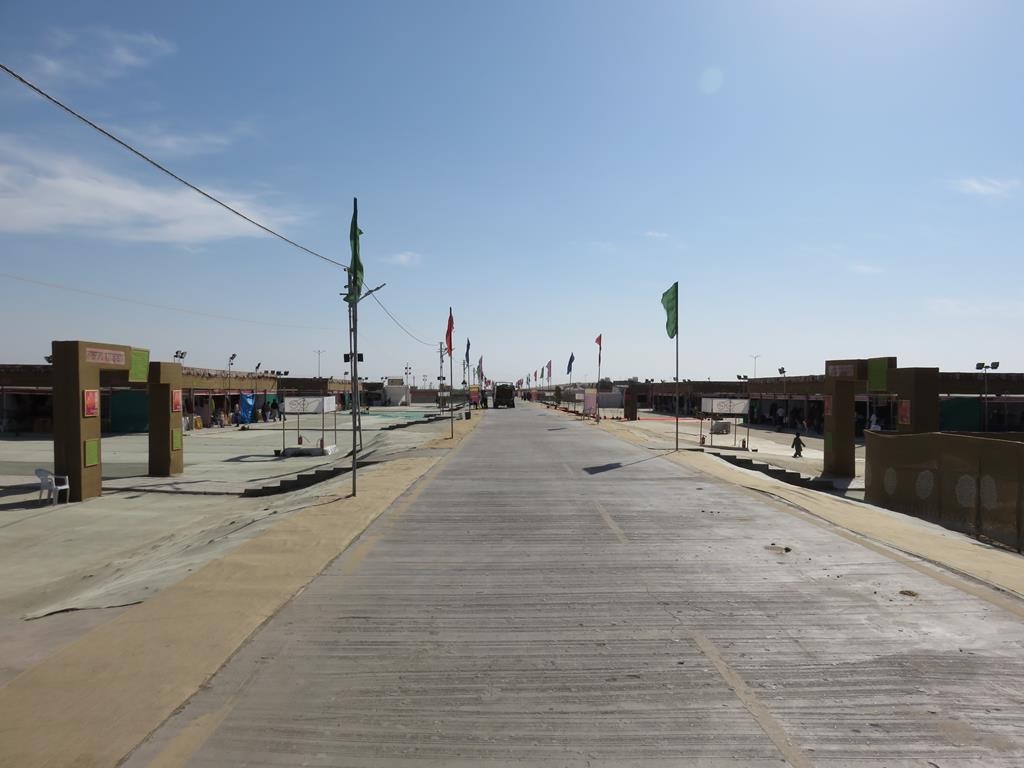
59 km south of Bhuj, Mandvi is the second city in the region, it is located on the Arabian Sea. The thing that almost everyone visits is the Vijay Villas palace 8 km to the west as well as the beach. The day well underway, so I did not visit it, preferring to walk in the small streets of the city. There is also an open-air shipyard where you can see large wooden boats under construction. In short, I stayed a short time, the city is of limited interest to me.
It is also possible to visit the surrounding villages to discover local crafts (for more detail you can contact us).
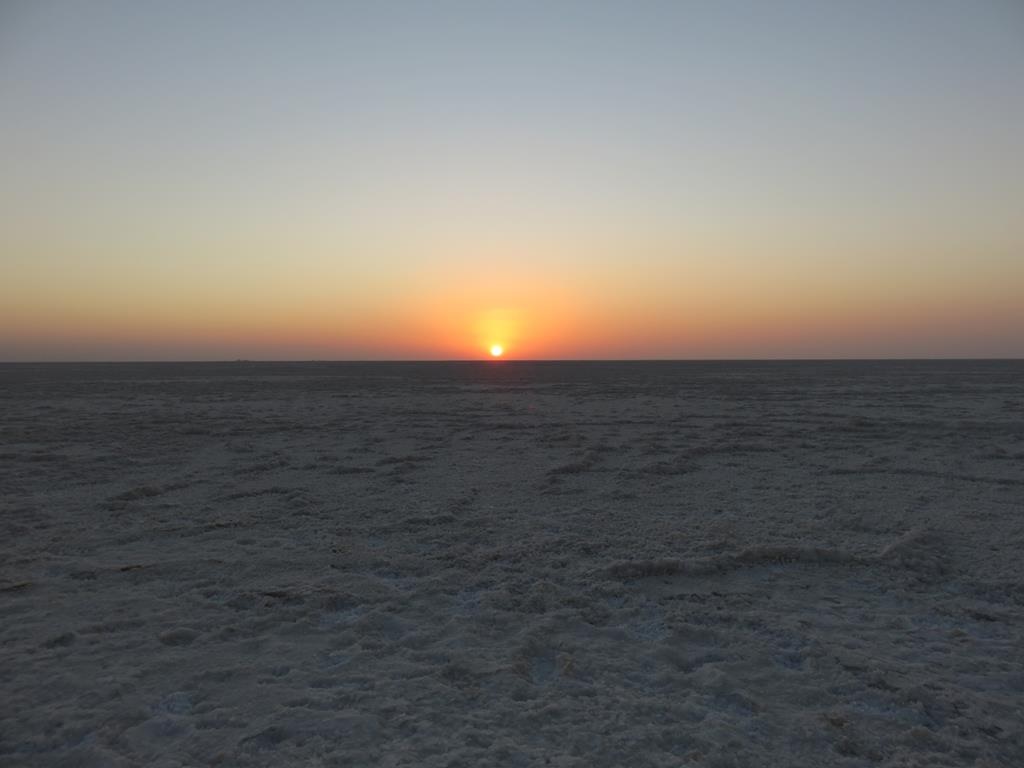
The White Rann is the thing to do. It is a huge salt marsh, all dressed in white, which is best visited from November to March, when there is no more water. During the monsoon, the marsh is covered with 15 meters of water. It is the largest salt reservoir in the world, it is very impressive when you walk on it.
To organize the trip over a day, I went through the tourist office which referred me to a travel agency (opposite the bus stand). After making inquiries, I embarked on this option: jeep with driver (obligatory) to do the circuit in the day: 2400 rupees. At the last minute, a young Indian joined forces with me, which allowed us to divide the price by 2. There is also the possibility of doing it independently by renting a car or a motorbike. Car rental was not profitable, I don’t have a motorcycle license and scooter rental does not exist, so I fell back on an agency.
The circuit: passing through the Bhirandiyara checkpoint to buy the permit (tax for the government) to enter the zone controlled by the military (because of the border with Pakistan), then first stop at Kala Dungar (which means black hill), the highest point of the region to admire the White Rann. The view is beautiful, but difficult to take a photo, I think because of the heat; there is a light veil that prevents having beautiful colors.
Then return on our steps, to visit the village of Ludiya (small village of a few inhabitants) to see the local crafts. It is a very small village with huts that serve as housing. The crafts are entirely handmade (various fabric objects and carved wooden furniture). The products are magnificent especially since some are quite complex to make.
Then head to Dhordo, the gateway to the White Rann. I was surprised to only visit one village. The driver told us that the villages were of limited interest, I think because of the festival organized by the government every year for 4 months, with dozens of shops to allow locals to sell their crafts; so there is almost nothing left in the villages.
Dhordo is a village in the middle of the desert, which is enlarged by a tent village to host the festival. After the festival site, continuing on the road we finally arrive at the gate of the White Rann. The cars stop at the parking lot, then you can either walk on the salt or finish the road on foot for 1.5 km in the middle of the salt. Once you get to the end, the landscape is magnificent: blue for the sky and white for the ground, it is really impressive. If you continue straight for 50 km, you arrive at the Pakistani border. But hey, it’s forbidden especially since it’s closely monitored by the military.
The highlight of the day: seeing the sun set from 6:30 p.m. At first, it starts to set slowly, then everything suddenly speeds up to disappear completely in less than 30 minutes. I expected to see the color of the salt change to an orange color, but none of that, the salt turns gray instead (it’s also pretty). It’s really an ideal place to take pictures, the landscape is flat and there are no obstacles. In the pictures I took with my camera (Canon Powershot SX700), there is a picture with the sun setting in the distance.
The next one is the sun itself taken by zooming in to the maximum (30x). I’m quite happy with the result, as the picture is not blurry, which is very very difficult without a tripod. Half an hour later, the day completely disappeared to make way for a very very dark sky (impossible to see anything). The day I went, it was the day after the full moon. Unfortunately, it was not possible to wait 1h30 more to see the moon rise and light up the White Rann, the driver had to return quickly (especially since it is almost a 2 hour drive to return to Bhuj).
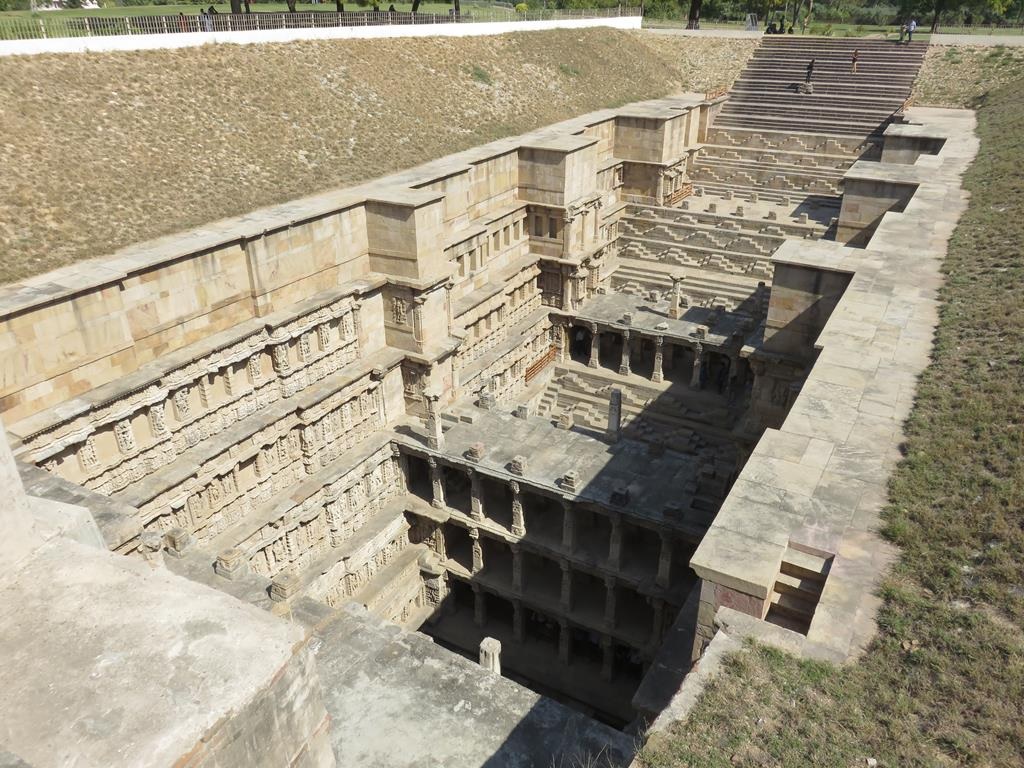
Modhera is 360 km from Bhuj, in northern Gujarat. I visited the only interesting thing in the city which is the Sun Temple, built in 1026 AD. The special thing: the sculptures that only represent erotic scenes! This temple reminded me of the one in Konark in Orissa, which I find much prettier with its chariot wheels.
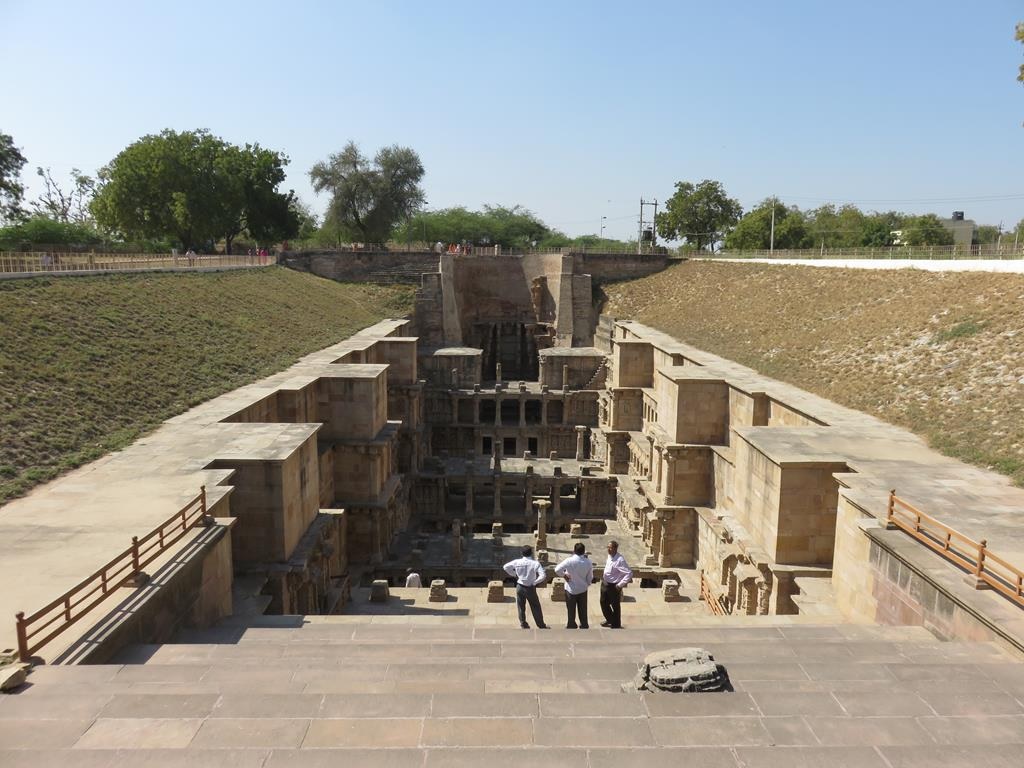
Patan is 36 km north of Modhera. Here is an archaeological site listed as a UNESCO World Heritage Site: the Rani-Ki-Vav (the Queen’s Stepwell). It is a stepwell on 7 levels of stairs (Stepwell), built in 1063 at the request of Rani Udayamati in memory of her husband King Bhimdv I. The shape of it resembles a temple, it is richly decorated with hundreds of sculptures. The site was only discovered in 1980 by archaeologists. Worth a visit, it is unique in its kind.
The other thing, located just behind the Rani-ki-Vav is the Sahastralinga Tank, it is a medieval water reservoir dating from the 11th-12th century.
So I spent almost four weeks in Gujarat, it is a state that deserves to be visited even longer, there are so many things to visit… This also explains the length of the article and the quantity of photos that I share with you!
Gujarat is a very interesting state to discover the Jain religion (5 million followers worldwide), but also the Muslim religion, very present with mosques everywhere. Located in the west of India, Gujarat offers varied landscapes, excellent roads, and… very few trains. I don’t know why, there is a railway network, but very few trains run there. So travel is by bus with, for me, added fatigue. English is very little spoken in this state; however, I always found someone who spoke it. And fortunately, because all the information is in Gujarati (the local language)…

316 km from Mandu, it took me 12 hours to reach my destination, with 3 buses and 1 train! My fear was confirmed: I beat my record for slowness in transport in India, despite reduced waits at each change. Left at 8:15 in the morning, I put my bag down at 8:15 p.m. Long day of transport and especially tiring with the buses. And again, I ended up by train instead of taking one or two additional buses.
First thing to do: find a place to stay for 4 nights. As always at this time, it is much less obvious than before 6 p.m. After being refused several times in hotels even by moving up a category, I managed to find one for only… one night at a reasonable cost considering the range (1100 rupees all the same). In fact, all the accommodations are stormed because of the vadfest (Vadodara festival) for a week and it so happens that I arrive right in the middle of it…
In order not to waste time, instead of going to bed, here I am in the street at night looking for accommodation for the following days, without success. One thing is sure, no question of spending hundreds of rupees to sleep. At worst, I leave the city.
The next morning, being next to the new bus center, I took the opportunity to find out about my next destination. The new bus center is in fact a brand new mall on 5 floors with more than 300 spaces for small shops (3/4 are still empty). A real Western-style shopping center. It is also, I am told, the largest bus center in India with 16 platforms for buses (the catch: everything is in Gujarati for the timetable)!!! And the most surprising, 2 large dormitories on the second floor: 1 for men, opened 1 month ago and 1 for women under construction.
Still little known, it is almost empty, so this is where I stayed for the next 3 nights. Phew, here I am settled. Another surprising thing, on the third floor a large closed hall with an Italian-style decor for eating. Here several counters offer varied cuisine as part of a cooking competition. Then the meal is taken in the hall with from time to time a projection on a white wall in the style of the Festival of Lights of Lyon. All this, only during the festival. Needless to say, I took the opportunity to eat something other than Indian dishes. And for those who are bored, right next door, there is a video game room…
During the davfest, the cathedral was closed and all the masses were in the sanctuary. Blessed davfest, thanks to this I discovered a sanctuary dedicated to Mother of the abandoned (the Virgin Mary), hidden in small streets. Mass in the morning and… in the evening, with crowds and a special animation during the festival. What happiness. On the eve of the march for life in Paris in January, I took the opportunity to entrust to Mary, our sick France and also the whole world, which kills its (future) citizens.
Mother of the Abandoned, welcome under your protection all those whose lives are threatened by men and bless those who give death as well as those who give the order so that they can discover how precious life is and that it is a gift from God. Amen.
Vadodara is a city that does not exist in tourist guides, because there is nothing interesting to visit that would be worth stopping there. Well yes, maybe to discover the new mall 2 steps from the train station and the small sanctuary of Mother of the Abandoned 3 km away (Mother of the Foresaken in English). In fact, I stopped there to have Sunday mass and because it is a gateway to visit Gujarat. The second reason was to visit Pavagadh nearby.

Located about sixty kilometers east of Vadodara, Pavagadh is a hill station with a Hindu temple at the top (Kalika Mata temple), perched at an altitude of nearly 800 meters. The site is located in a 10th century archaeological park. To get there, the journey can be done entirely on foot, or by jeep followed by the cable car. To avoid taking too long to climb (and avoid driving), I took the jeep to do the first 5 kilometers and then I finished the journey by climbing more than 1500 steps in a little over an hour.
Here it is impossible to die of hunger or thirst, there are shops all along the steps. The advantage: there are tarpaulins that provide shade (to protect the goods), the disadvantage: you don’t enjoy the landscape much. Once at the top, there are also shops right up to the foot of the temple.
But then how do we transport the astronomical quantities of goods knowing that there is no road or heliport? On the backs of men? Well no, on the backs of donkeys. Here, dozens of donkeys regularly go up and down (as well as their shepherds) the 1500 steps (some of which are quite steep) to satisfy our desires for consumption…
The reward, once you reach the top, is to enjoy the landscape and the Hindu pilgrims happy to go and worship at the temple (some come from far away). In itself, the temple is small and is not architecturally interesting. On the other hand, the fact that few tourists come has given me some great encounters. That is the advantage of going to places that are not very touristy.
Jainism
Before reading the rest, I strongly advise you to read Jacques-Henri Prévost’s article on Jainism. The article is a bit long, but it is the one that explains Jainism quite clearly. This religion-philosophy is quite complex to understand, but it deserves a closer look because it has influenced certain people including Mahatma Gandhi.

Shatrunjaya Hill (meaning victory square, at an altitude of 600 meters) is one of the 10 sacred places for the Jain community, located 320 kilometers west of Vadodara and 2-3 kilometers from the center of Palitana, which serves as a drop-off point for all amenities (there are not really any interesting things to visit).
It is at this place that Adinatha or Rishabha (9th century BC), attained enlightenment (liberation). For some, he is considered the first Jain tirthankar (person who overcame the cycles of death and rebirth) and therefore the founder of Jainism, for others it would be Mahavira (6th century BC), the 24th tirthankar, the reformer of Jainism.
Access is only on foot: 3600 steps to climb in nature to reach a collection of 850 Jain temples and 3500 gods. Personally, it took me 1 hour, stopping only a few seconds here and there, the goal was to arrive before the sun hit hard (there are few shaded places). The temples were built between the 11th and 12th centuries and then between the 14th and 16th centuries.
The temples are grouped into 3 groups, each surrounded by a wall, including 1 large temple and then all around dozens of small temples (most are tiny) all very well maintained. The Jains constantly polish the place and especially all the gods (some of whom are even dressed). An atmosphere of prayer and peace reigns here, and you are welcomed for what you are. Jains do not force you to make this or that offering, they essentially count on the generosity of your heart.
And what strikes me the most: seeing people smiling and happy to come to pray here (or to live here). I really perceive a beautiful little tight-knit community. If you have any questions, please ask them, the Jains will be delighted to chat with you.
Note: while visiting the main temple (in the group on the left), I saw people going upstairs. Curious as I am, I also went up (everyone can go there). Then I saw some of them go through a small door giving access to the upper floor (access reserved). I did the same and found myself above the heart of the temple. Then, I went through a tiny door leading to the rather steep roofs (access prohibited).
And at the highest point of the roofs, I saw men singing and shouting with joy… Suddenly, festive atmosphere and breathtaking view of the landscape. Of course, I asked permission to do so knowing that it is very exceptional (moreover I do not know why it was done).
On the way back, I met an Indian who currently lives in America and who comes on pilgrimage here every year. So I took the opportunity to ask him questions about Jainism, very good meeting. This place is an essential stop in Gujarat.

Porbandar is located 120 km south of Junagadh, on the shores of the Arabian Sea. Here I am in the south of Gujarat in the birthplace of Mahatma Gandhi (1869-1948), the one who defended his country against the English to one day obtain the independence of India (in 1947), by preaching peace and non-violence. He is the hero of Indian history, he is present everywhere: on all bank notes, each city has an important street named after him (M.G. road), statues everywhere…
So I visited his birthplace, then right next door the museum dedicated to him, in order to understand his life a little better. Apart from that, Porbandar is just a coastal town with its port (and its boat building) and its beach that offers nothing else interesting to visit. Only stop there if you have time to waste.

111 km west of Porbandar, Dwarka is one of the 4 places where a Hindu can make his most sacred pilgrimage (with Kedarnath to the north, Puri to the east, Rameswaran to the south and Dwarka to the west). It is a coastal city, with an impressive number of accommodations of all categories to accommodate pilgrims.
All the shops are mainly located around the Dwarkadhish temple dedicated to Krishna, located near the sea. The stone temple is small, it has the particularity of having 5 floors. In short, the visit to the temple is very quick, but the fervor of the Hindus is very present. Apart from the temple, there is nothing else to visit. To complete the visit of the region, do not hesitate to go to the island of Bet Dwarka.

Bet (Beyt) Dwarka is an island off the coast of Okha, located at the tip of Gujarat west of Dwarka (30 km). The tourist guide I have mentions that there is a temple with a giant statue of Krishna, which is what motivated me to go there. Well, none of that, it doesn’t exist on the island… In fact, there is the Shri Dwarkadish temple where many people come to pray as part of their pilgrimage after Dwarka.
The temple is also small and the visit is necessarily guided. So I joined the group. The guide was quite dynamic (everything is in Gujarati) and we followed a small circuit passing in front of deities. Some deities are hidden behind doors, the group waits, the excitement rises and suddenly… the doors open and the group lets out a cry of joy. And there you go, we move on to the next deity!!! And quickly, because there is another group waiting. When the group had stopped for a teaching time (?), I slipped away…
The visit was quickly over, so I took off (from the crowd) and headed towards the tip of the island 6 km away, crossing the small streets of the village, then I took a shared rickshaw that dropped me off at the temple at the end of the island, and finally I finished the journey on the seaside for 2.5 km… in the company of a group of young people and teachers.
When explaining to some Indians that I wanted to go to Dunny Point (the tip of the island), a class teacher offered to take me with his young people. When I arrived at Dunny Point, I discovered a camp where they had set up for 3 days. This camp is open from November to March only for school trips. It is an area prohibited to visitors because of the conflicts with Pakistan, the border being close. But hey, being invited, I was able to stay there, swim with the young people and have lunch with them… Very good time together, they were delighted to see me (they must not see foreigners very often) and me too, and funny thing on the day of Saint John Bosco.
On the way back, I stopped at Mithapur where I was able to have the anticipated Sunday mass. Oh yes, there are very very few Catholics in Gujarat (a few hundred), so the churches are naturally few and the masses too. Finally, by anticipating things a little I get there.

150 km north of Dwarka, it is a stopover town to go to the northwest of Gujarat. This town suffered major damage in a major earthquake in 2001. It is built around an artificial lake (currently empty) with a palace in its center, which has become a museum that I have not visited. This is also where you will find the only solarium in the world that allows you to treat skin problems directly with the sun’s rays using a system of mirrors.
The second one, which was built in France, was destroyed during the Second World War. It had been recommended to me by the class teacher I met in Bet Dwarka. Except that it was damaged in 2001 and there are no more spare parts to repair it. It is currently closed (hidden under tarpaulins) due to the construction of a new, more modern solarium. Finally, in the old town, there are scattered all over the place magnificent Jain temples richly decorated inside that are worth stopping by.

The Kutch (or Kahchch) district is located in the northwest of the state of Gujarat, bordered by the Arabian Sea to the south and west and by Pakistan to the north. The district is divided into 3: the Rann of Kutch located in the north which includes the White Rann, the Little Rann to the east which includes a reserve that shelters the last Asian wild asses, and the Great Rann for the rest of the region. Kutch is part of the Thar Desert (with also a part in the state of Rajasthan and a part in the south and east of Pakistan).
Rann in Hindi literally means “something that intermittently becomes wet and dry”. Kutch means “desert”.
This district suffered a major earthquake in 2001 (7.9 on the Richter scale), leaving a lot of damage. Today, life has resumed its course, still leaving some visible traces.

Here I am in the capital of the Kutch district (located in the Great Rann), 300 km from Jamnagar. Bhuj is the city from where we leave to explore the surroundings, which is one of the most visited places in Gujarat by all tourists, locals and the Indian government!
The city deserves a day’s stop to visit some rather interesting monuments:
The Pragmahal Palace: built in an Italian Gothic style in the 19th century, it was seriously damaged by the 2001 earthquake. While the exterior walls are relatively in good condition (with some nice cracks), the interior has not really been restored: we walk on concrete, the furniture is completely damaged, the ceilings are falling apart and pigeons come to live in the place with all the dirt that brings.
However, there is just one large room that has been restored (the first one we visit) that is worth a look and the 20 rupees entrance fee. To take pictures of the room, it is 50 rupees more (the rest is free). To complete the visit, we will have a view of the city from the top of the clock tower.
The Aina Mahal: located right next to the Pragmahal palace, it was built in the 18th century and partially destroyed by the earthquake. It is made of white marble, decorated with gold, mirrors installed everywhere and magnificent furniture, paintings, pictures… all this in a Hindu European style. I did not take any pictures, because I did not pay the extra entrance fee (50 rupees) especially since there is little light to take beautiful pictures. A must visit.
The Swaminarayan Smruti Mandir Temple: a new Hindu temple made entirely of white marble, it was officially inaugurated in 2010. It replaces the old temple destroyed in the earthquake. It is located in the center of a large hotel complex. The whole thing is quite impressive. To the left of the temple, there is a: modern museum, presenting various old objects, I think related to the old temple. The museum is not really signposted and the free entrance is a bit hidden (curiosity is an asset). A must-see. Photos are prohibited.
Visiting the villages in the region to discover local crafts: it is possible to do this, the easiest is to go to the tourist office for information. Kodak 10 km north of Mandvi, I stopped at Koday to visit a Jain temple that is currently being finished. It is located on the side of the road. As in Bhuj, it is a large complex with a temple made of white marble, finely carved by hand and with a grinder. It is quite impressive to see what men are capable of doing: beautiful. It is surrounded by an enclosure comprising a few dozen small temples, each containing a statue. The temple is open to all, it is active. However, photos are also strictly forbidden there. Worth a visit.

59 km south of Bhuj, Mandvi is the second city in the region, it is located on the Arabian Sea. The thing that almost everyone visits is the Vijay Villas palace 8 km to the west as well as the beach. The day well underway, so I did not visit it, preferring to walk in the small streets of the city. There is also an open-air shipyard where you can see large wooden boats under construction. In short, I stayed a short time, the city is of limited interest to me.
It is also possible to visit the surrounding villages to discover local crafts (for more detail you can contact us).

The White Rann is the thing to do. It is a huge salt marsh, all dressed in white, which is best visited from November to March, when there is no more water. During the monsoon, the marsh is covered with 15 meters of water. It is the largest salt reservoir in the world, it is very impressive when you walk on it.
To organize the trip over a day, I went through the tourist office which referred me to a travel agency (opposite the bus stand). After making inquiries, I embarked on this option: jeep with driver (obligatory) to do the circuit in the day: 2400 rupees. At the last minute, a young Indian joined forces with me, which allowed us to divide the price by 2. There is also the possibility of doing it independently by renting a car or a motorbike. Car rental was not profitable, I don’t have a motorcycle license and scooter rental does not exist, so I fell back on an agency.
The circuit: passing through the Bhirandiyara checkpoint to buy the permit (tax for the government) to enter the zone controlled by the military (because of the border with Pakistan), then first stop at Kala Dungar (which means black hill), the highest point of the region to admire the White Rann. The view is beautiful, but difficult to take a photo, I think because of the heat; there is a light veil that prevents having beautiful colors.
Then return on our steps, to visit the village of Ludiya (small village of a few inhabitants) to see the local crafts. It is a very small village with huts that serve as housing. The crafts are entirely handmade (various fabric objects and carved wooden furniture). The products are magnificent especially since some are quite complex to make.
Then head to Dhordo, the gateway to the White Rann. I was surprised to only visit one village. The driver told us that the villages were of limited interest, I think because of the festival organized by the government every year for 4 months, with dozens of shops to allow locals to sell their crafts; so there is almost nothing left in the villages.
Dhordo is a village in the middle of the desert, which is enlarged by a tent village to host the festival. After the festival site, continuing on the road we finally arrive at the gate of the White Rann. The cars stop at the parking lot, then you can either walk on the salt or finish the road on foot for 1.5 km in the middle of the salt. Once you get to the end, the landscape is magnificent: blue for the sky and white for the ground, it is really impressive. If you continue straight for 50 km, you arrive at the Pakistani border. But hey, it’s forbidden especially since it’s closely monitored by the military.
The highlight of the day: seeing the sun set from 6:30 p.m. At first, it starts to set slowly, then everything suddenly speeds up to disappear completely in less than 30 minutes. I expected to see the color of the salt change to an orange color, but none of that, the salt turns gray instead (it’s also pretty). It’s really an ideal place to take pictures, the landscape is flat and there are no obstacles. In the pictures I took with my camera (Canon Powershot SX700), there is a picture with the sun setting in the distance.
The next one is the sun itself taken by zooming in to the maximum (30x). I’m quite happy with the result, as the picture is not blurry, which is very very difficult without a tripod. Half an hour later, the day completely disappeared to make way for a very very dark sky (impossible to see anything). The day I went, it was the day after the full moon. Unfortunately, it was not possible to wait 1h30 more to see the moon rise and light up the White Rann, the driver had to return quickly (especially since it is almost a 2 hour drive to return to Bhuj).

Modhera is 360 km from Bhuj, in northern Gujarat. I visited the only interesting thing in the city which is the Sun Temple, built in 1026 AD. The special thing: the sculptures that only represent erotic scenes! This temple reminded me of the one in Konark in Orissa, which I find much prettier with its chariot wheels.

Patan is 36 km north of Modhera. Here is an archaeological site listed as a UNESCO World Heritage Site: the Rani-Ki-Vav (the Queen’s Stepwell). It is a stepwell on 7 levels of stairs (Stepwell), built in 1063 at the request of Rani Udayamati in memory of her husband King Bhimdv I. The shape of it resembles a temple, it is richly decorated with hundreds of sculptures. The site was only discovered in 1980 by archaeologists. Worth a visit, it is unique in its kind.
The other thing, located just behind the Rani-ki-Vav is the Sahastralinga Tank, it is a medieval water reservoir dating from the 11th-12th century.
So I spent almost four weeks in Gujarat, it is a state that deserves to be visited even longer, there are so many things to visit… This also explains the length of the article and the quantity of photos that I share with you!
Copyright © 2025 Delighted Journey | All Rights Reserved.